Adelaide, the capital of South Australia, is located on the Torrens River, between the Adelaide Hills and the Gulf of St Vincent (Wongayerlo).
The Kaurna people
The Kaurna people have lived in the Adelaide (Tarndanya) region for at least 25,000 years. The River Torrens (Karrawirra Pari -red gum forest river), which provided fish, water and other
food sources, was also the location of a popular camping ground.
Theirs was a hunter-gatherer culture, with
beliefs and traditions passed on orally from generation to generation and by dance and artistic practice.
The society of the Kaurna people was based on moiety systems, whereby everything, including people, animals, songs, dances, ceremonies and land, is split into two halves, based on strictly applied laws and observances.
Moieties are
found in many parts of the world. However, for Aboriginal people, moieties also dictated that marriages could only take place between members of opposite moieties.
 |
| Natives ready for a corroboree at Anna Creek, South Australia, 1939, Bernhardt, Clarence, (Lesley Gilbert), NLAUST |
By managing the natural environment with fire regimes related to ceremonial practices, the Kaurna people also moved with the seasons over their territory using their knowledge of seasonal changes and the land.
Knowledge about the Kaurna language comes mostly from a published dictionary of 2,000 Kaurna words recorded by the German Lutheran missionaries, Christian Gottlieb Teichelmann (1807-1888)
and Clamor Wilhelm Schürmann (1815-1893), who came to Adelaide in October 1838. A school was established, supported by
Governor George Gawler and Aboriginal children were taught to read and write in their language.
 |
| Portrait of unidentified seated Aboriginal man with beard, South Australia, B. Goode & Co., photographic artists, 69, Rundle Street, Adelaide, between 1864 and 1874 |
William Cawthorne, an artist and teacher who
arrived in Australia in 1841, had a great interest in the Aboriginal people and was friendly with an Aboriginal man named Kadlitpina/Kadlitpinna, known as "Captain Jack" by the early colonial settlers. Cawthorne made many
interesting observations. His
Rough Notes on the Manners and Customs of the Natives, written in 1844, was published in 1925-26.
Kadlitpinna "Captain Jack" was also appointed as an honorary constable. He was given a baton and uniform, and he attended official meetings with the Governor of South Australia.
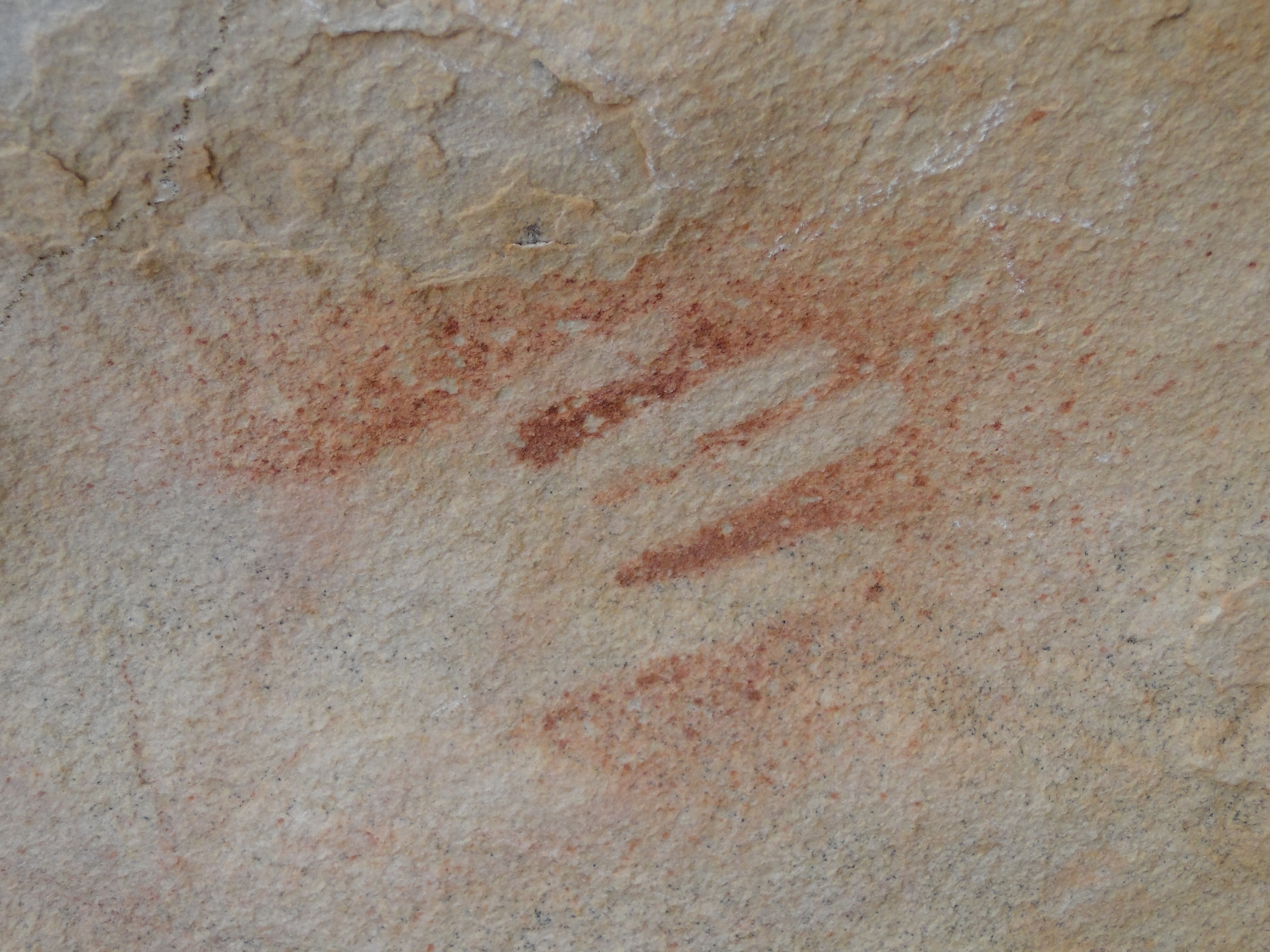 |
| An ancient art work of a hand outlined by the artist by spraying red ochre from the mouth. In the caves at Yourambulla, South Australia. | |
 |
| A tribe of natives on the banks of the River Torrens, Alexander SCHRAMM (18 December 1813 - 1864) |
1820s
In the 1820s, Edward Gibbon Wakefield was the spokesman for a group of English social theorists who proposed the idea that the Continent of Australia should establish a separate colony of free settlers, who would be free of the convict “stain”, which at this time, was a terrible stigma and cause of shame.
South Australia, and its capital of Adelaide, named after Queen Adelaide of the United Kingdom, began as a British settlement in 1836.
Colonel William Light was appointed as Surveyor General and given the task of finding the
site for the settlement, which had: “a commodious harbour…..a considerable tract of
fertile land, an abundant supply of fresh water and extensive sheep-walks”.
Three ship-loads of settlers had already landed in South Australia ready to
start their new life, and not long afterwards, Colonel Light decided the right spot for a permanent settlement was about 10km inland of the Torrens River.
 |
| Colonel William Light - self portrait This image was painted by William Light circa 1815 |
Governor Hindmash arrived on the HMS Buffalo to put the official seal on the settlement site chosen by Colonel Light. But on arrival, Hindmash did not approve of this site for a permanent settlement. Colonel Light refused to budge in his choice and threw himself into making extensive and ambitious plans for the establishment of a future city.
The Foundation Act of South Australia, stated:
"Nothing in these our Letters Patent shall affect or be construed to affect the rights of any Aboriginal Natives ... to the actual occupation or enjoyment ... of any lands therein now actually occupied or enjoyed by such Natives."
Colonisation, however, was to bring big changes
to the land and the culture of Australia’s Indigenous people, who had been genetically and socially isolated from the rest of humanity for 50, 000 years.
Soon the life and society of the Kaurna people, in the place that would become Adelaide and South Australia, would be transformed.
The Early Days of The Colony
 |
| Adelaide, North Terrace, 1839 |
A public debate and ballot determined that Colonel Light’s choice would go ahead --won by 218 to 127. The orderliness and abundant green space of Colonel Light’s plans were mostly adhered to. And so, Adelaide became the first planned city in Australia, which developed not as a penal settlement or military base but as a place for free settlers.
After Colonel Light surveyed the surrounding countryside of Adelaide, the colonists began to move out of the town centre, where many stone houses were being built to start farming. This created a boom in land prices. Land allotments which had been purchased for 14 guineas, sold for up to £100.
In 1838, Colonel Light, who was extremely ill with tuberculous, was ordered by the authorities in London
to change his surveying method to speed up the work. He resigned in protest, though there were public attempts to have him reinstated as surveyor-general. Light was replaced by Captain Charles Sturt and he died in the following year.
1840s: The Town Grows
In 1840 the first Agricultural Show was held in the yards of Fordham's Hotel, Grenfell Street, Adelaide.
The Queen's Theatre is the oldest surviving theatre building in mainland Australia. The theatre opened with
a performance of "Othello" in January 1841.
 |
| Commercial Inn, Port Adelaide, circa 1845, SLSA |
 |
| Queen's Head Hotel, Kermode Street, North Adelaide, SA, 1845. The Queen's Head Hotel (at the centre of this picture) was opened in 1838. State Library of South Australia |
In 1847, the Church of England school, St Peter's College, was established, as was Pulteney Grammar School, also in the Anglican tradition.
The Savings Bank of South Australia began trading from a room in Gawler Place in 1848.
 |
Port Adelaide, 1848. Painting by S.T. Gill. SLSA
|
1850s
In 1850, the store G. P. Harris and J. C. Lanyon opened on Hindley Street. In the same year, the law courts moved to new premises in Victoria Square.
The Queen's Theatre was remodelled with a Georgian facade and re-opened in December 1850 as the Royal Victoria Theatre.
 |
| VICTORIA THEATRE, Adelaide, about 1850. The Qneen's Theatre shown was demolished, and the Victoria erected on the same site. Chronicle (Adelaide, SA : 1895 - 1954), Thursday 3 October 1935 |
By 1850, as South Australia was in a good financial position, the British Government extended responsible government to South Australia - a form of limited democracy, with the addition of elected members to the Legislative Council.
In 1852 The first overland transport of gold arrived in Adelaide and Australia's first gold coin was minted at the Government Assay Office in Adelaide.
The Royal Society of South Australia,
established as the Adelaide Philosophical Society in 1853, first met at Stephens Place (Gawler Place).
By 1854, the area around the Stag Hotel on the corner of East Terrace and Rundle Street was operating as a fruit and vegetable market.
The first telegraph line and
steam railway between Adelaide and Port Adelaide opened in 1856. In the following year of 1857, the rail line between Adelaide and Gawler opened, as does the Adelaide Botanic Gardens.
In 1856, the first steam train ran between Adelaide and Port Adelaide, stopping at Bowden, Woodville and Alberton. Most of the rail lines around Adelaide were built before 1900.
 |
| Advertiser (Adelaide, SA : 1931 - 1954) |
J.A. Holden & Co., a saddlery business in Adelaide began in 1856. This firm would later become General Motors-Holden, the iconic former automobile manufacturer.
Self-Government
The Parliament of South Australia began in 1857 when the colony was granted self-government.
In 1858, the telegraph
line between Melbourne and Adelaide opened and in 1858, the Melbourne-Sydney line was in operation. This allowed European news arriving by ships to spread faster across the country. Soon, the telegraph was an essential part of the
government and commercial activities, and the operation of the railway, navigation, meteorology, astronomy and scientific purposes and the standardisation of time.
 |
| View of Adelaide, SA, from the "Register" tower looking towards Mitcham. See Cadasteral plan for Acre 168 where several buildings will be seen instead of paddocks. The spire of St. Andrew's Church appears to the right of centre. Circa 1858 |
The first Town Hall in South Australia
was built at Norwood in 1859.
1860s
By 1860, the foundation of the East-end Market was operating on a vacant lot owned by Richard Vaughan on East Terrace.
The Thorndon Park reservoir
was completed in 1860, to supply water to the Adelaide population.
 |
| A view of Thorndon Park Reservoir, featuring the tower. Two men in bowler hats sit on the bank and look out across the water. State Library of SA |
Propertied women in the colony of South Australia were granted the right to vote in local elections (but not parliamentary elections) in 1861.
 |
| South Australian Weekly Chronicle (Adelaide, SA : 1858 - 1867), Saturday 23 March 1861 |
Adelaide Town Hall was completed in 1866.
 |
| Freemason's Tavern, Hindmarsh Hotel, Black Eagle Hotel, Adelaide, SA, 1865. Shows three hotels along Pirie Street. In the foreground is The Freemason's Tavern, the Hindmarsh Hotel is on the near corner of Hindmarsh Square, and the Black Eagle (later the Aurora) on the far side of Hindmarsh Square. The Adelaide Brewery can also be seen. The Aurora, Hindmarsh, and the Brewery have all been demolished. State Library of South Australia |
 |
| Rainbow Tavern, Gouger Street, Adelaide, SA, 1865. A detail from Duryea's Panorama of Adelaide, photographed from the Town Hall tower. The Rainbow Tavern was established in 1853 and subsequently known as the Rainbow Inn and Rainbow Hotel before becoming the Supreme Court Hotel in 1874. Taken sometime in 1865, State Library of South Australia |
 |
| Prince of Wales Hotel, Angas Street, Adelaide, SA, 1865. Detail from Duryea's Panorama of Adelaide, photographed from the Town Hall tower. State Library of South Australia |
 |
| Captain John Hart was a seafarer from the age of 12 and managed a whaling station at Encounter Bay. After several voyages to England he established Hart's Flour Mill at Port Adelaide. He was the first President of the Port Adelaide Football Club, a Member of Parliament and Premier and Treasurer for 18 months. He should have been credited for the success of the Overland Telegraph Line. About 1865. SLSA |
 |
| Young Queen Inn, Gawler Place, Adelaide, 1865, SLSA |
In 1867, Prince Alfred, Duke of Edinburgh, was the first member of the Royal Family to visit Australia. The Prince's ship docked at Glenelg on the outskirts of Adelaide on the afternoon of 31 October 1867. Huge crowds of people were gathered, lining the roads to the city. As night fell, 40,000 gas lights, which had only been installed in June of that year, lit the scene.
 |
| Scene in Adelaide during the visit of the Duke of Edinburgh in 1867, SA. News (Adelaide, SA : 1923 - 1954), Tuesday 9 October 1934 |
1870s
Port Adelaide Football Club was founded on 12 May 1870.
 |
| A detail from Duryea's 1870 Panorama of Adelaide, SA, photographed from the Town Hall tower. Prince of Wales Hotel, Angas Street, was established in 1848. In 1924 this hotel was converted into premises for the Returned Soldiers and Sailors Association. From 1860-1864 known as the Supreme Court Hotel (not to be confused with the premises on Gouger Street). The building has been demolished. The rear of St Francis Xavier's Cathedral can be seen bottom left. |
 |
| Photos from about 1870, Adelaide, SA. 1. This picture taken from the north wall of the City. Baths, depicts King William Road as it was before thepresent bridge spanned the Torrens. 2. North Terrace in the early days. Thepicture is -taken from where theUniversity now. stands end from left to right the buildings visible are the Adelaide dub, Institute {side view), and Police Barracks. .Mail (Adelaide, SA : 1912 - 1954), Saturday 26 September 1925 |
 |
The, old police station in King William Street, Adelaide, SA, It was situated next to the nost office on. the site now occupied by the telegraph office. Mail (Adelaide, SA : 1912 - 1954), Saturday 26 September 1925 |
In 1872, Adelaide became the first
Australian capital to be linked to Imperial London with completion of the Overland Telegraph.
 |
| The Adelaide General Post Office building, built 1867–1872, National Library of Australia |
 |
| King William Street Adelaide, looking north from Victoria Square - Google Art Project.jpg |
First cricket match played at Adelaide Oval in 1873. First international cricket match at the ground in the following year.
 |
| In 1874 a side representing England led by W.G. Grace defeated a South Australian side by 7 wickets in what was the first international cricket match at the Adelaide Oval, SLSA |
The University of Adelaide was established on 6 November 1874 after a £20,000 donation by grazier and copper miner Walter Watson Hughes, along with support and donations from Thomas Elder.
 |
| Mitchell Building, University of Adelaide (with man and penny farthing bicycle) & the Mortlock Library, North Terrace, Adelaide (looking West), 1879–1886, National Library of Australia |
Old Parliament House was constructed in stages over 65 years from 1874 to 1939.
The Adelaide Children's Hospital
was founded in 1876 and officially opened in North Adelaide in 1879.
In 1877 Adelaide Bridge across the Torrens opened.
 |
| Adelaide Children's Hospital showing the eastern front. William McMinn was the architect of this building following a commission from Sir Samuel Way who appreciated the architect's work on his house, "Montefiore". This building was demolished in 1967. 1878, SLSA |
 |
| Caledonian Hotel, O'Connell Street, North Adelaide, SA, c1878. On the corner of O'Connell Street and Barton Terrace, the Caledonian was established in 1869. State Library of South Australia |
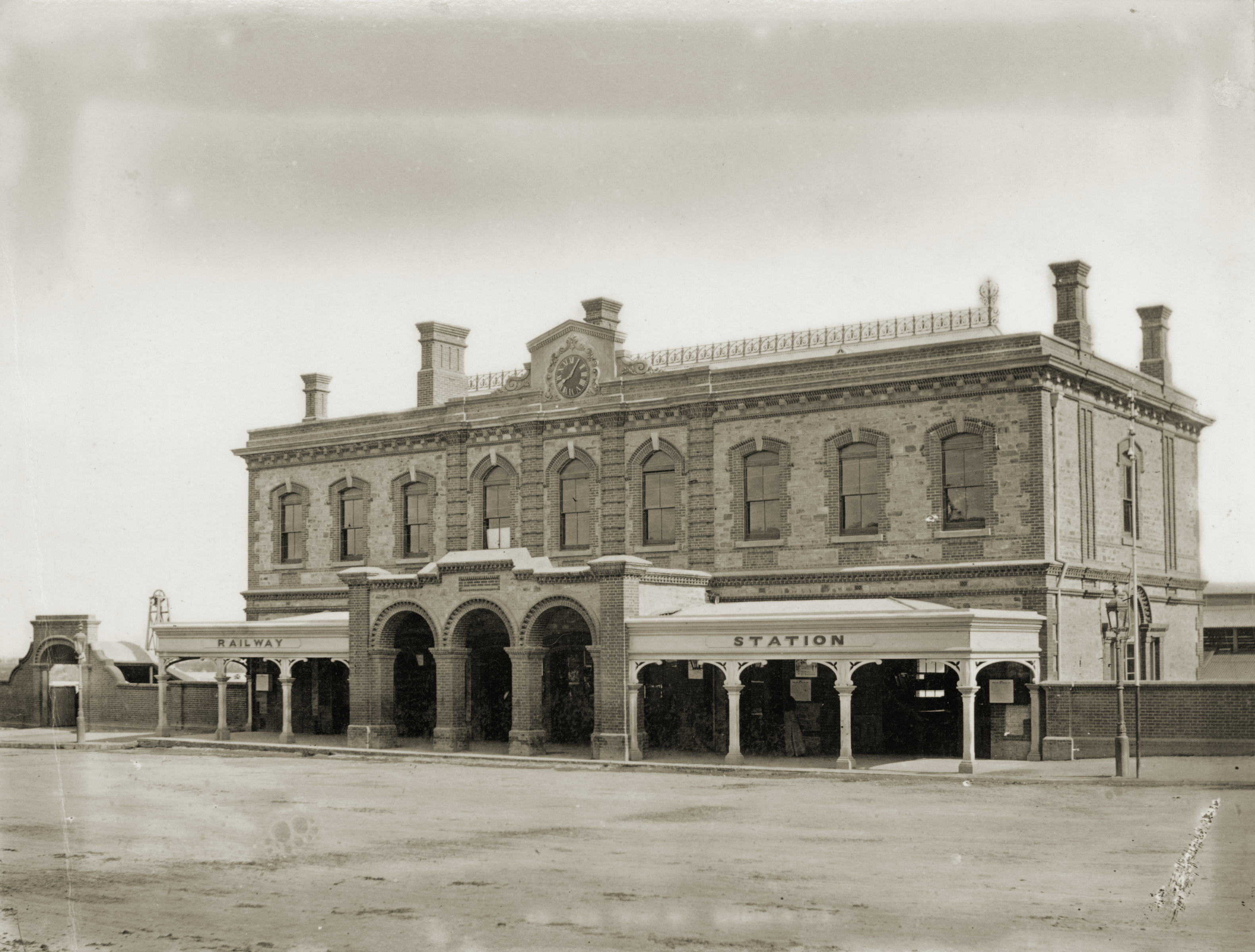 |
| Adelaide Railway Station, built in 1856, after alterations made in 1878 when a second storey was added, SLSA |
 |
| Castle Inn, Hindley Street, Adelaide, SA, 1878, State Library of South Australia |
Adelaide became the first city in Australia to introduce horse trams in 1878.
.jpg) |
| Circa 1908, a double-decked car (tram) and the horse that hauled it, in a street in a suburb of Adelaide, SLSA |
 |
| Hindley St., Adelaide [picture]. between 1869 and 1889. |
1880s
In 1880 the first telephone exchanges opened in Australia, including Adelaide.
 |
The Lion Hotel and Brewery, Jerningham Street, North Adelaide, SA, circa 1880, SLSA
|
Prince Albert Victor opened the National Gallery of South Australia in 1881, located in Adelaide.
Adelaide Zoo opened on 23 May 1883, occupying 6.5 hectares (16 acres).
Australia's first agricultural college was founded at Roseworthy, 50km north of Adelaide, in 1883.
Adelaide Trades and Labor Council formed in 1884 to coordinate the activates of the many unions that had formed in Australia, such as carpenters, tailors, bakers, carriers, cordwainers and coachmakers.
 |
| Established in 1837 as Fordham's Hotel, became the Sturt Hotel in 1845 and the Sturt Arcade from 1886 until its closure in the early 1990s. The hotel building (on the left of this photograph) dates from 1885 and no longer exists.State Library of SA |
 |
| King William Street, Adelaide, SA, circa 1885. Horse drawn-cabs, mainly in the middle, wait for fares as three horse trams seek refuge in a passing loop. Water carts, used to suppress dust, have not long passed. State Library of South Australia |
The South Australian Freemasons Lodge formed before the colony was settled, but the Grand Lodge formed in 1884.
The plan to create
the largest shopping arcade in the Southern Hemisphere, the Adelaide Arcade, linking Rundle and Grenfell streets, was formed in 1885.
 |
| Adelaide Arcade, SA, 1886, SLSA |
 |
King William street, Adelaide, SA, 1889 |
Adelaide's first public sculpture, unveiled in 1892, Venere di Canova, or Venus as she is known, is a copy of a work by the 18th-century Italian sculptor Antonio Canova. There was an outcry over the nudity of the sculpture and attempts were made to damage it, even by fire.
 |
| Venus di Canova funded by WA Horn 1892. Somewhat controversial at the time of its unveiling in1892, this piece was the first of Adelaide's street statues. It is a copy of the statue of Venus by Antonio Canova - the original is at the Pitti Palace in Florence. Pdfpdf |
Women Vote
The Parliament of South Australia endorsed the right of women to vote and stand for parliament in 1894.
 |
| A group of women university graduates at the University of Adelaide. Back row: Florence Haycroft, Mary Maude Kirby B.Sc., Laura Fowler. Front row: Susan S. Solomon, [unknown], Annie Treby. Circa 1891, SLSA |
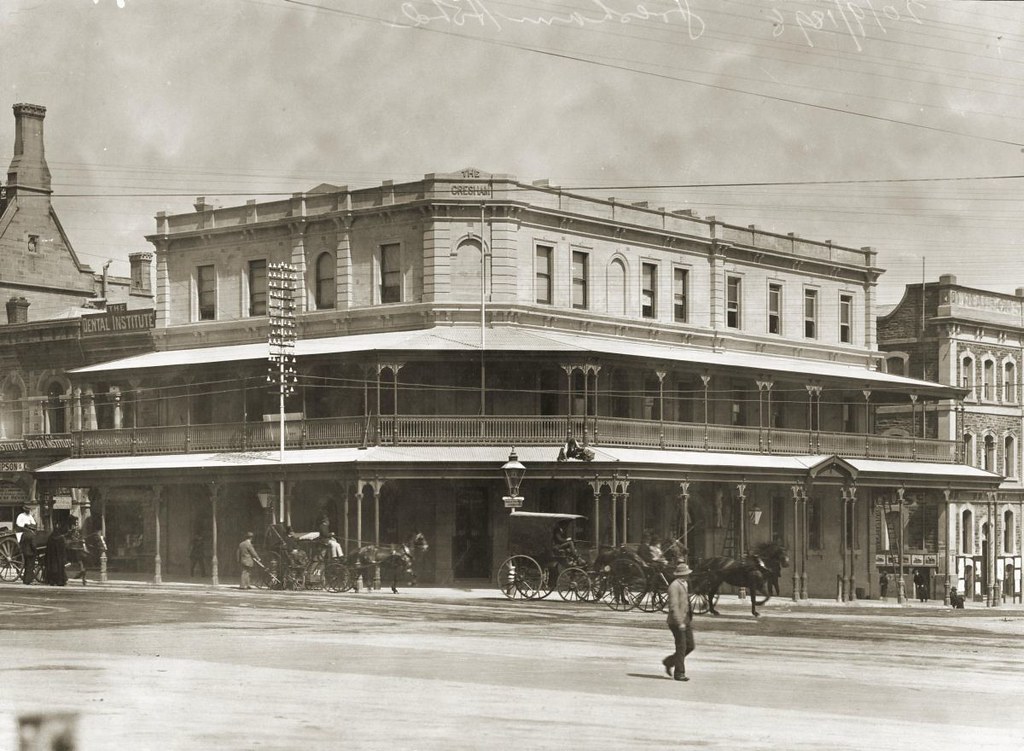 |
Gresham Hotel, Cnr King William Street & North Terrace, 1898. State Library of South Australia
|
Tranmere House was built in 1898 for George Hunt who was a merchant owning four large shops on Rundle Street opposite Adelaide Arcade. He built his mansion on a block
of land previously owned by George Morphett.
 |
| Tranmere House, Magill Road, Tranmere, Adelaide, built in 1898 |
In 1899 the South Australian contingent left Adelaide for the Second Boer War.
1900s: A New Century
In 1900 South Australia's first electricity station opened at Grenfell Street, Adelaide. And in the same year, the first electric street lights were installed.
 |
| South Australian Aboriginal people - very early 1900s |
 |
| Adelaide Royal Mail coach circa 1900, SA |
Adelaide became a state capital on 1 January 1901, with the Federation of the Australian colonies.
 |
| Procession along Rundle Mall, Adelaide, SA. Adelaide Observer (SA : 1843 - 1904), Saturday 10 September 1904 |
 |
| Florence Thomson, of Adelaide, travelled from Adelaide to Melbourne in March 1904, the first female to drive the trip. Her car was a riving a Beeston Humberette. Critic (Adelaide, SA : 1897-1924), Wednesday 22 February 1905 |
Adelaide High School established in 1908.
William Garnet South, was appointed as a protector of Aborigines in 1908, strove to provide shelter, food and clothing to "full descent' Aboriginal people, so that they would be "comfortable and happy for the remainder of their lives". However, he stated that "all children of mixed descent should be treated as neglected", so that "half-caste" Aboriginal children could be merged assimilated into the "white" community. This would lead to the Stolen Generations.
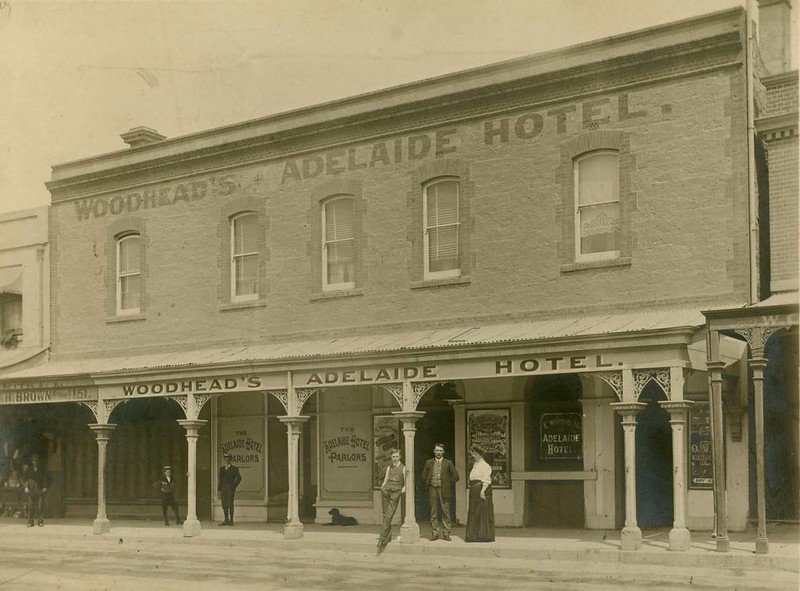 |
| Adelaide Hotel, Hindley Street, 1908, SLSA |
The Verco Building, Adelaide's first "skyscraper", with a total of 6 storeys and a basement, was completed by the end of 1912.
 |
NURSING STAFF OF THE NORTH ADELAIDE PRIVATE HOSPITAL, SA, Back Row—Nurses Daley, K. Leahy, Carter. J''a ulkner. Hiorden. (.'ullen, Haftery.
Central Row:—Nurses Cornelius, Solly. Deady, Pflamn, VleCuiinaeliy. McXally, C. l.enliy.Front Row:—Nurses Cockburn, Von <jer Boreii. Brett, (Graham. Scott, Brooks.Observer (Adelaide, SA : 1905 - 1931), Saturday 4 April 1908 |
 |
| This exhibit was specially made by Holden & Frost, whose manufactures of harness and saddlery are so well known, Critic (Adelaide, SA : 1897-1924), Wednesday 11 March 1908 9J.A. Holden & Co., a saddlery business in Adelaide began in 1856. This firm would later become General Motors-Holden, the iconic former automobile manufacturer) |
 |
| Oxford Hotel, O'Connell Street, North Adelaide, SA, c1909. The Oxford Hotel, on the right of the photograph, was established as the Princess Royal Hotel in 1859. It changed it's name to the Oxford in 1884 when it was rebuilt. State Library of South Australia |
 |
| Ward in the Children's Hospital in Adelaide, South Australia - 1900s, Aussie Mobs |
 |
Holden and Frost premises, Grenfell Street, Adelaide, SA, SLSA
|
 |
| Leigh Street, Adelaide, 1. The church office, 2. Welling Hotel in the early days, SA, Observer (Adelaide, SA : 1905 - 1931), Saturday 4 February 1911 |
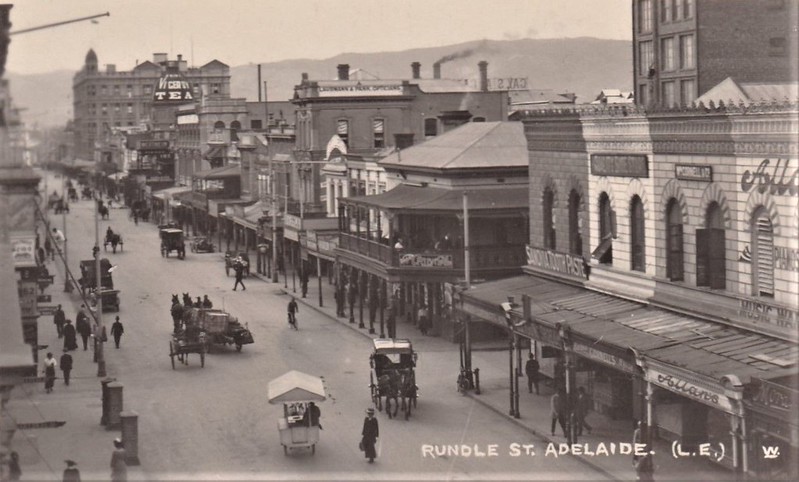 |
| Rundle Street, Adelaide, S.A. Circa 1912 |
 |
| View of the Vercoe Building on North Terrace, Adelaide, SLSA |
Australasia's first national Gallipoli Memorial was established in the Adelaide Park Lands, 7 September 1915.
WWI
 |
| GRG26/5/4 Photographic Portraits of South Australian Soldiers, Sailors and Nurses who took part in World War One. Number 2193 SEAMAN, Walter Battley. 10th Battalion. Place of birth: Adelaide. Residence: Torrensville. Killed in action. SRSA ref: GRG26/5/4/2193, State Records of SA |
 |
| The 27th Battalion was formed on 16 March 1915 at Ascot Park Camp, Adelaide, from recruits drawn mainly from South Australia. Embarking for the Middle East in WW1, Kaye |
In 1916 South Australia became the first state to shut public bars at 6 pm (the six o'clock swill).
 |
| GRG26/5/4 Photographic Portraits of South Australian Soldiers, Sailors and Nurses who took part in World War One. Number 1324 CANDY, Harold Joseph. 27th Battalion. Place of birth: Adelaide. Residence: Adelaide. SRSA ref: GRG26/5/4/1324, State Records of SA |
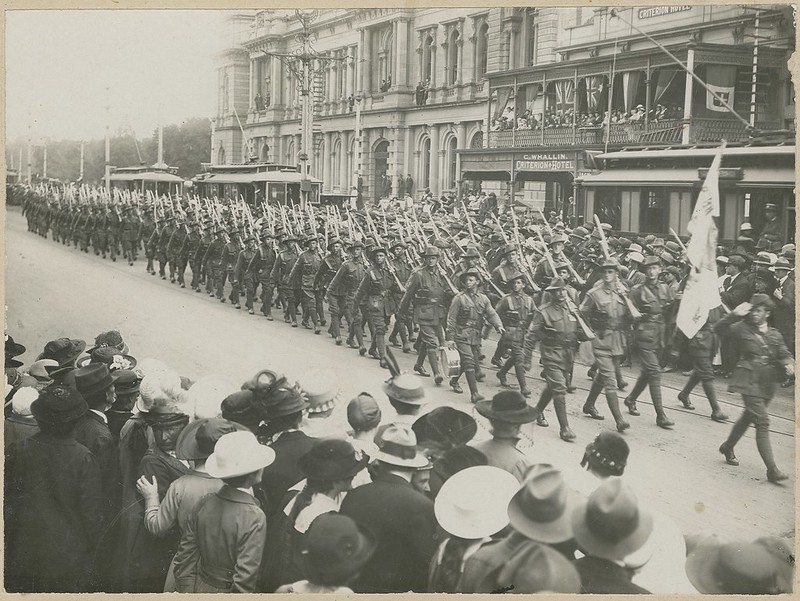 |
| Soldiers marching, King William Street, Adelaide, circa 1917, SLSA |
 |
| A mass of people have gathered in front of Parliament House to hear the Armistice Day address of His Excellency the Governor of South Australia., North Terrace, Adelaide, 1918, SLSA |
 |
| Crown Inn, Currie Street, Adelaide, SA. 1918. On the western corner of Currie Street and Rosina Street. Established in 1846 as the Golden Fleece Inn. It was the Crown Inn from 1871 to 1937, Coronation (1937-1979), Hotel California (1979-1984), Armstrong's Tavern (1984-1987), and finally the College Arms in conjunction with Adelaide TAFE College. The building has been demolished. State Library of South Australia |
 |
| George Pantonie, who died in the Adelaide Hospital last week. He was well knows to all sporting parties who visited the lakes and Coorong. He sang before Queen Victoria at Buckingham Palace, and he accompanied the Duke of Edinburgh on shooting excursions on the lakes. Observer (Adelaide, SA : 1905 - 1931), Saturday 19 January 1918 |
1920s
An aerodrome was built in 1921 at Albert Park, now Hendon, Adelaide.
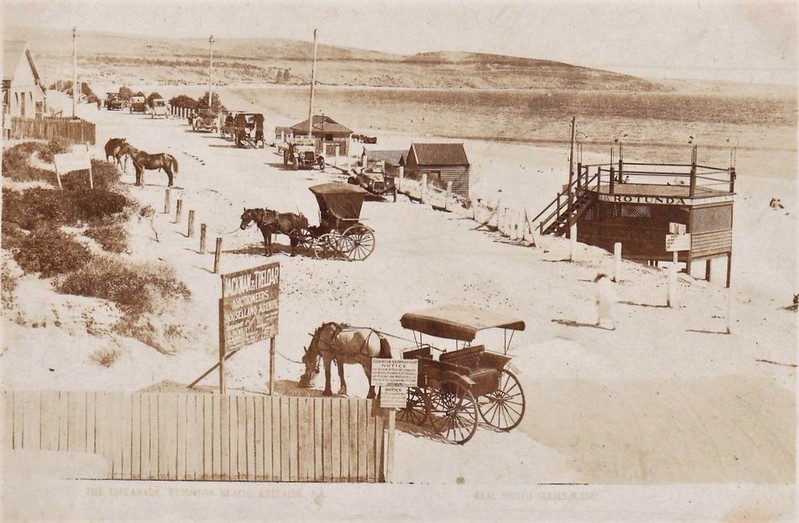 |
The Esplanade, Brighton Beach, Adelaide, S.A. circa 1921
|
 |
| Adelaide Hunt Club, Chronicle (Adelaide, SA : 1895 - 1954), Saturday 29 July 1922 |
 |
| King William Street, Adelaide, South Australia 1923, SLSA. King William Street, Adelaide, South Australia. Looking south toward the Town Hall (left) and Post Office (right) clock towers. The intersection with Rundle and Hindley Streets is in the centre foreground. |
 |
| Close view of Mr. 'Tommy', an Aboriginal police officer and tracker in Adelaide, South Australia. SLSA |
Radio broadcasting began in 1924.
The Royal Show moved to the Wayville Showgrounds site in 1925.
 |
| Race fashions, Observer (Adelaide, SA : 1905 - 1931), Saturday 26 March 1927 |
In 1928, the Arbitration Court introduced an award which forced wharfies who had not been engaged in the morning, to return and offer themselves again in the afternoon. The wharfies went on strike and when strikebreakers (scabs) were brought in, they attacked. Volunteers were brought in as special constables, to patrol the port armed with a rifle and bayonet. The strike failed. The "scabs" were preferentially employment over the union members, leading to many years of anger and bitterness.
 |
| Argus (Melbourne, Vic. : 1848 - 1957), Tuesday 2 October 1928 |
1930s
 |
| Mail (Adelaide, SA : 1912 - 1954), Saturday 1 October 1932 |
The Adelaide trolleybus system was part of the public transport network in Adelaide from 1932 until 1963.
 |
| A front three-quarter view of trolleybus number 406 in Adelaide, South Australia. No. 406 was a Leyland trolleybus, Doug Colquhoun - Trams Down Under Archive |
The Adelaide Christmas Pageant was established in 1933, by Sir Edward Hayward, owner of the Adelaide department store John Martin's.
 |
| King William Street from the balcony of the Adelaide Town Hall, about 1930s, State Records of SA |
 |
| John Martin's window display for 'Paul Duval' cosmetics, Rundle Street, Adelaide, SA, c1935, State Library of South Australia |
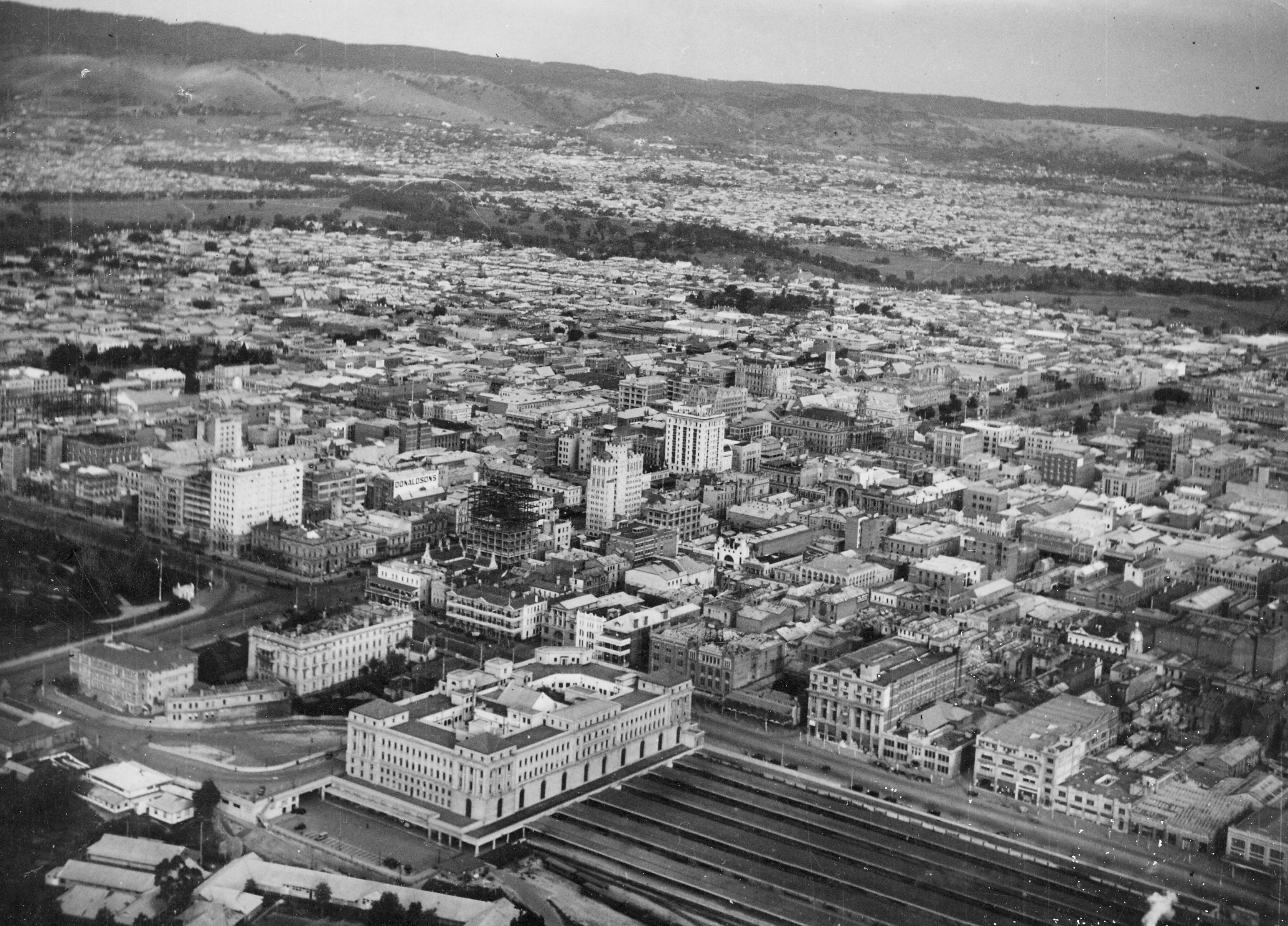 |
| Parliament House and Adelaide Railway station in 1935, SLSA |
 |
| Hunstman Hotel, O'Connell Street, North Adelaide, SA, 1936. State Library of South Australia. The Huntsman's Hotel. Established in 1849 and traded until 1960 when the licence was transferred to the Hotel Australia. This building, which dates from 1882, had a number of uses after 1960, including the Lutheran Church Library, until it opened as the Archer Hotel in 2003. |
 |
| Rundle Streeet, Adelaide, SA, Chronicle (Adelaide, SA : 1895 - 1954), Thursday 12 August 1937 |
 |
| CLARRIE LONG, a full-blooded aboriginal, well-known in Adelaide, now regularly visits incoming liners at Outer Harbor and sells boomerangs to overseas travellers. An English traveller takes a picture of Clarrie Daily News (Perth, WA : 1882 - 1955), Saturday 19 February 1938 |
 |
| Adelaide Used Car Company, Currie Street, Adelaide, SA, 1938, State Library of South Australia |
New Parliament House was completed in 1939 at a cost of £241,887.
 |
| Hindley Street Adelaide, SA. 1939, SLSA |
1940s and WWII
 |
| TO BE MADE IN ADELAIDE. Experts examining a new type of anti-tank gun, hundreds of which are to be made at the works of General Motors Holden's in Adelaide. Chronicle (Adelaide, SA : 1895-1954), Thursday 29 August 1940 |
The Birkenhead Bridge opened in 1940 connecting Port Adelaide's downtown with the suburb of Birkenhead.
 |
NAVY WEEK. The .large model of an Australian battle cruiser which attracted much attention in Rundle Street last week in connection with the Navy League drive. Chronicle (Adelaide, SA : 1895 - 1954), Thursday 18 July 1940 |
 |
| NATIVE ART. Last week an exhibition of aboriginal art attracted much attention in Adelaide. Chronicle (Adelaide, SA : 1895 - 1954), Thursday 6 November 1941 |
 |
| Chronicle (Adelaide, SA : 1895 - 1954), Thursday 14 November 1940 |
 |
| Members of the Womens' Auxiliary Transport Corps marching in Adelaide, SA, during the promotion of a 'Liberty Loan' fundraising campaign, World War 2. SLSA |
 |
| Victory March, Adelaide, Chronicle (Adelaide, SA : 1895 - 1954), Thursday 29 August 1946 |
 |
| V.C. WINNER Lieut. Tom Derrick and Lieut. Reg Saunders congratulate each other after gaining commissions at the same officers' training school. Tom Derrick Born in the Adelaide suburb of Medindie, South Australia. Lieutenant Reg Saunders was the first Aboriginal Australian to be commissioned as an officer in the Australian army |
Peace
 |
Photograph of North Terrace in Adelaide, taken in 1947 by Max Dupain
|
 |
The Adelaide Christmas Pageant, Chronicle (Adelaide, SA : 1895 - 1954), Thursday 18 November 1948
|
1950s
 |
| The six o'clock swill, Mail (Adelaide, SA : 1912 - 1954), Saturday 22 April 1950 |
 |
| The General Post Office and Clock Tower - Adelaide, 1950. The Town Hall is the lesser spire on the left of the photo. Running through Victoria Square are F type drop centre trams of the Municipal Tramways Trust. SLSA |
The epicentre of the 1954 Adelaide earthquake was in the suburb of Darlington, occuring at 3:40 am 1 March.
 |
| Corner of King William Street and Waymouth Street, Adelaide, SA, about 1954, State Records of SA |
 |
| The visit of Her Majesty the Queen and His Royal Highness the Duke of Edinburgh, Adelaide, SA, 1954, State Records of SA |
 |
| Swain House, King William Street, Adelaide, SA,1952. 422-424 King William Street. Erected in 1952 on a vacant site. The building no longer exists. State Library of South Australia |
 |
| 212 Pulteney Street, Adelaide, SA The facade was added in 1952. The building no longer exists. 1952. State Library of South Australia |
 |
| Flinders Street looking west to Franklin Street. Victoria Square on left, Taken circa 1955, State Records of SA |
The permanent settlement of Adelaide was
established by the British and populated mostly by the British and Irish. However, German immigrants increased in 1838, with many taking up farming in the Adelaide Hills. Southern European migration to South Australia, which had hitherto been small, increased in the 1920s and 1930s, with Greeks and Italians contributing significantly to the cultural life of Adelaide.
Other groups to settle in Adelaide include Jews, Afghans and settlers from the Middle East and more recently from Asia.
 |
YUGOSLAV CHILDREN Michael (left) and Karl Keserovic with the Serbian Orthodox minister, Father G. Djonlich, on arrival in Adelaide today. Two young boys stepped off the Melbourne Express in Adelaide this morning to begin a new life. News (Adelaide, SA : 1923 - 1954), Saturday 3 July 1954 |
Adelaide Airport was established in 1955.
 |
WHEN the Harlem Globetrotters— famous U.S. basketball players — visited Adelaide Children's Hospital on Tuesday, a two-year-old aborigine, Bert Kite, stepped up to play with the ball brought by big 'Rookie' Brown. It was the biggest and heaviest ball the youngster had ever held.Chronicle (Adelaide, SA : 1895 - 1954), Thursday 28 January 1954 |
The Queen's Mother made a solo tour of Australia and visited Adelaide in 1958.
On 5 September 1959, NWS-9 was the first television station to broadcast in Adelaide.
1960s
In 1964, The Beatles appeared on the balcony of the Town Hall in front of hundreds of fans.
Torrens Island Power Station began operations in 1967.
1970s
Rundle Mall opened on 1st September, 1976. The escalators were built around 1982 and removed in 2000.
The first ever Adelaide Italian Festival was held in 1976 in Rundle Mall.
1980sThe Hotel Centralia, on North Terrace,
was established in 1845 as the Black Swan Inn but changed its name to the Centralia in 1940. In the 1980s/1990s the hotel became a popular venue for live music, especially punk/alternative bands. The building was demolished in the early 1990s.
The population of Adelaide reaches 1 million people in 1984.
1990s
2000s
 |
| The three-tonne, six-metre tall original sculpture by surrealist artist Salvador Dalí's "Triumphant Elephant" is on loan to Rundle Mall in 2022, Adelaide, SA
|
Then and Now
 |
| Glynde Corner in Felixstow, South Australia. Then |
 |
| Glynde Corner in Felixstow, South Australia, Now |
Around Adelaide
 |
| The Stag Hotel, Adelaide, South Australia. Located on the corner of Rundle Street and East Terrace. Established in 1849 |
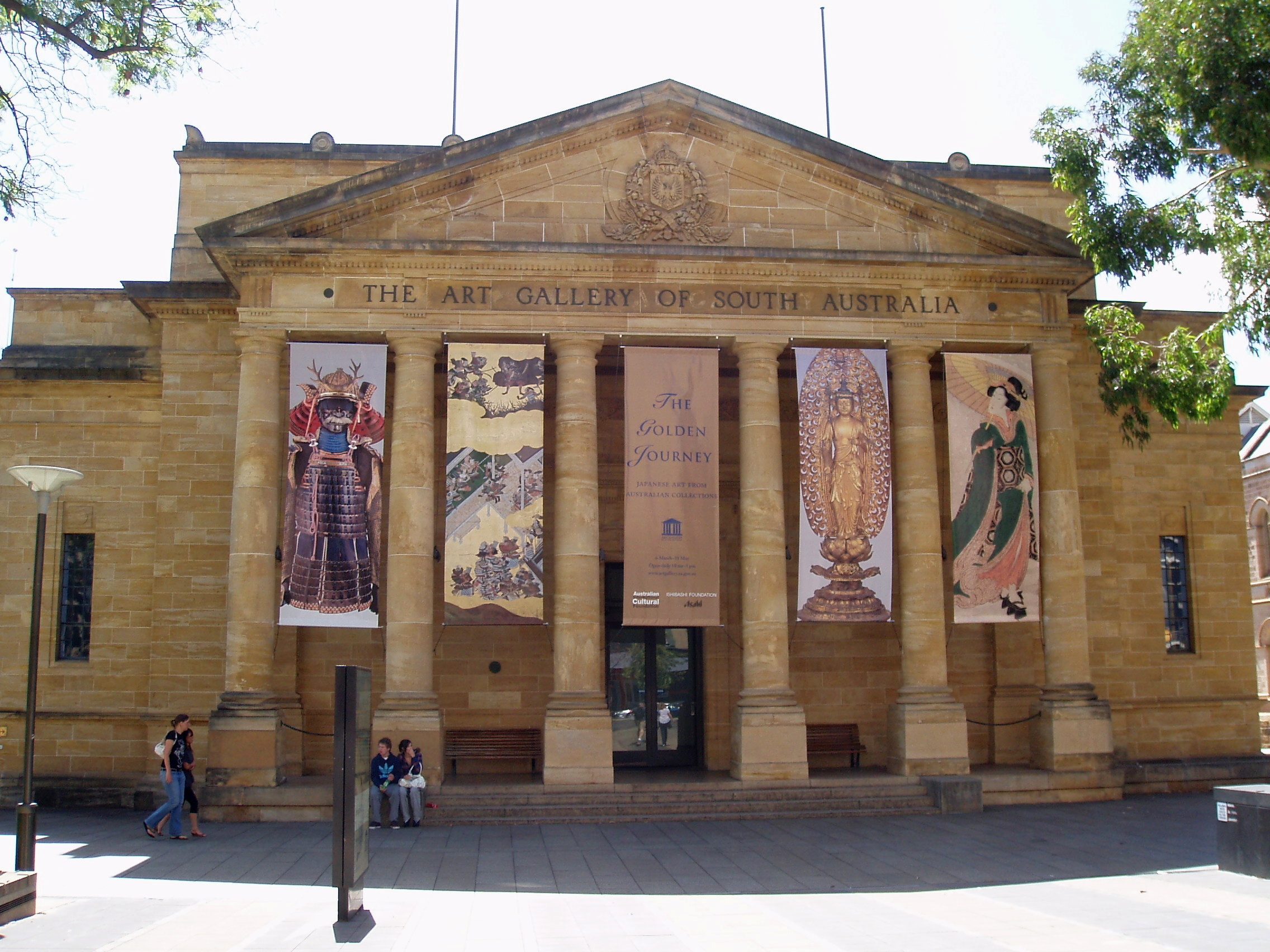 |
| Art Gallery of South Australia, North Terrace, Adelaide, SA, berichard. The National Gallery of South Australia was established in June 1881 |
 |
| The Supreme Court of South Australia, 1 Gouger St, Adelaide |
 |
| The Museum of South Australia, Adelaide |
 |
| Bonython Hall & the Conservatorium of Music, University of Adelaide, North Terrace |
 |
| Goodman Building, Adelaide Botanic Gardens |
 |
| St Francis Xavier's Cathedral, Adelaide |
 |
| Adelaide Post Office architectural detail | |
 |
| St Peter’s Cathedral, Adelaide |
 |
| Eynesbury house, Adelaide, South Australia, by denisbin |
 |
| The Adelaide Arcade, Rundle Mall, was built in 1885, 16 years before federation. |
 |
| Parliament House, South Australia Corner of North Terrace and King William Street |
 |
| The Mayfair Hotel, formerly Colonial Mutual Life |
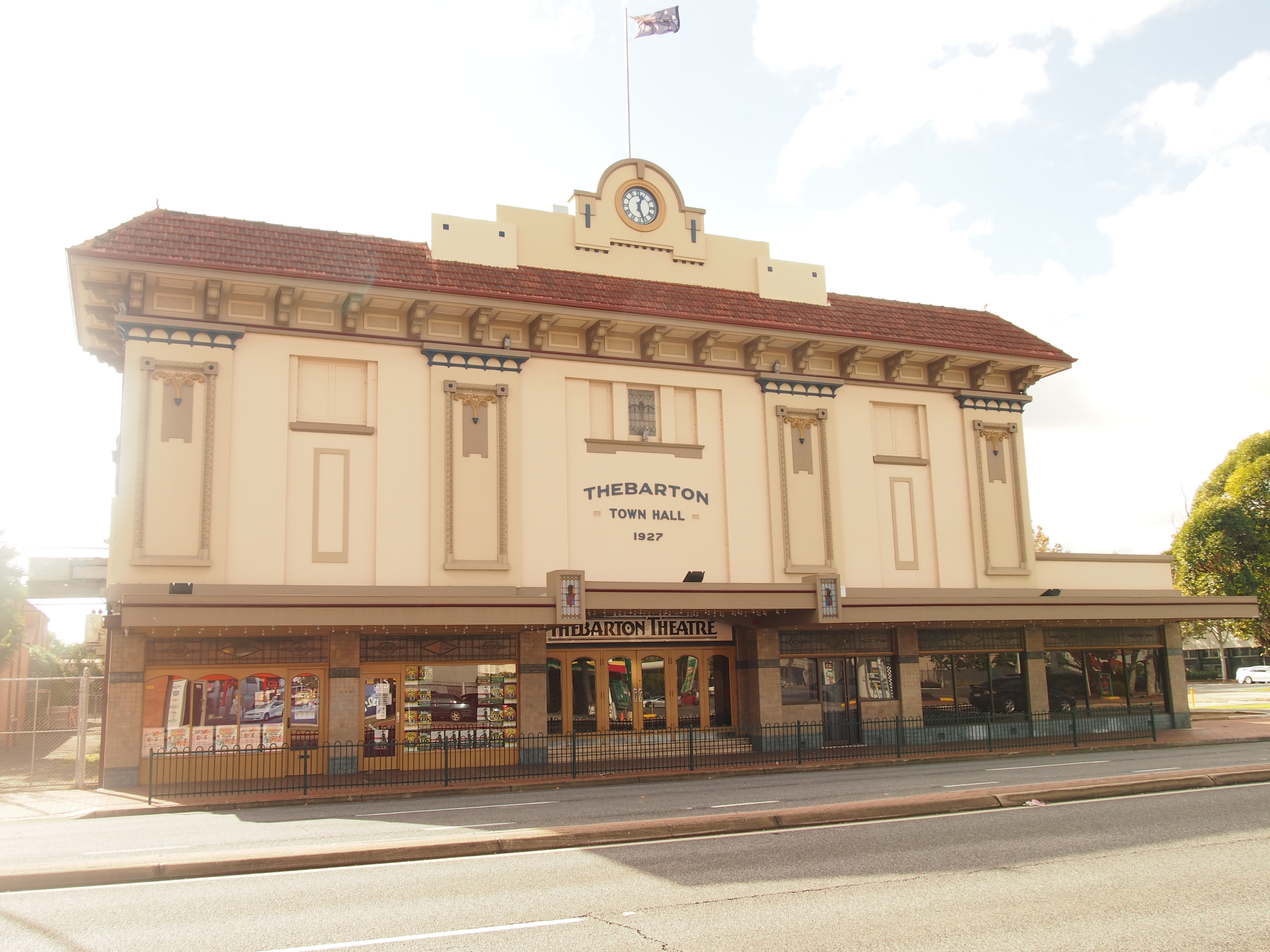 |
| Thebarton Theatre is located in the inner-western Adelaide suburb of Torrensville. |
 |
| The Capri Theatre located in Goodwood, a suburb of Adelaide built in the Art Deco style. |
 |
| Greek Orthodox Church, Adelaide |
 |
| Old German Club, Adelaide |
 |
| Hindley Street, Adelaide (circa 1903) |
 |
| St Francis Xavier's Cathedral, Victoria Square |
 |
| Barr Smith Library, part of the University of Adelaide |
 |
| The former Stock Exchange building built in 1901 |
 |
| The Epworth Building was built in 1927 |
 |
| The Grand Hall of the Grand Lodge of Freemasons Adelaide built in the 1920s |
 |
| The Ruthven Mansions are mong the earliest of Australia’s multi-storey apartments, they were built in two stages (1911-12 and circa 1914) |
 |
| Stay Hotel, 299 Rundle Street, Adelaide. Constructed in 1903 |
 |
| West's Coffee Palace was built in 1903 |
 |
| Sadly, some of Adelaide's historic and irreplaceable buildings are to be demolished |
 |
Front of Ayers House, North Terrace, Adelaide, South Australia, Originally named Austral House,
288 North Terrace |
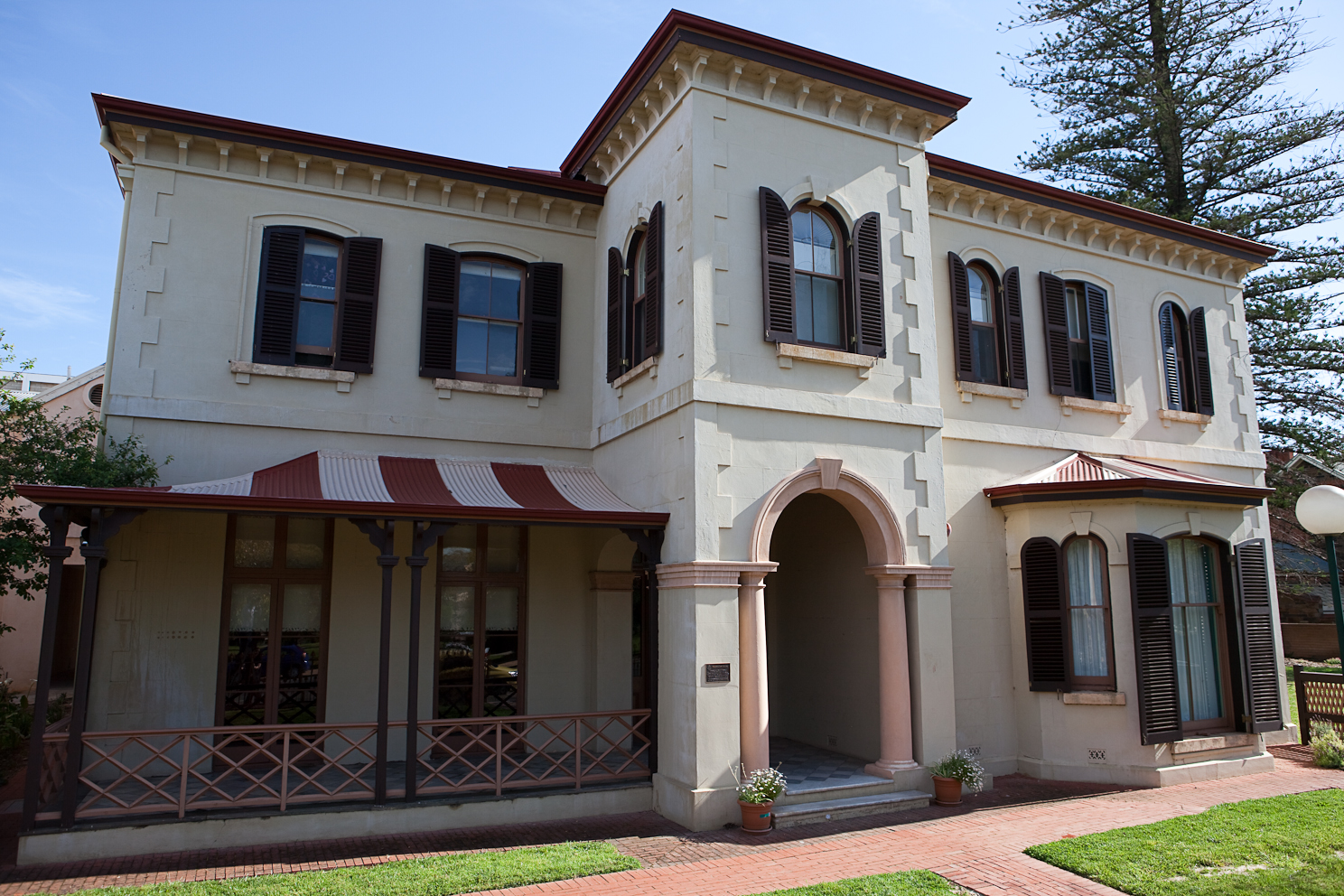 |
| Lincoln College Federation House, Brougham Place North Adelaide, 32 Brougham Place. Former residence of Sir Richard Chaffey Baker who was a barrister, pastoralist and politician and one of the founding fathers of federation. |
 |
| Lincoln College Abraham House, Brougham Place North Adelaide, built about 1896 |
 |
| Milne House, Lincoln College Administration Building, 45 Brougham Place North Adelaide, Built for George Milne, son of Sir William Milne, wine merchant (1901) |
 |
| North Adelaide Baptist Church - Stables and Church Hall144-146 Tynte Street, North Adelaide, South Australia.Image courtesy of Adelaide City Council., ID: C1348/096 National Trust of South Australia |
 |
| The former North Adelaide Primitive Methodist Church property is now privately owned. It was built next to the 1850s chapel in 1881/82, National Trust of South Australia |
 |
| The Piccadilly Cinema, O’Connell Street, Adelaide opened on the 23 October 1940 |
Things To Do and Places To Go
Novels Set in South Australia
Heart of the Country (Flinders Ranges Series #1) by Tricia Stringer
The Fire in the Stone by Colin Thiele
Hello from the Gillespies by Monica McInerney
Adelaide (The New South Cities Series #5) by Kerryn Goldsworthy
Pieces of a Lie by Rowena Holloway
Information
Kaurna Country Traditional Foods, Medicines and Remedies



















.jpg)






















































































































